Table of Contents
 Lawnmowers that start and stop can damage the engine, lead to an unevenly cut lawn, and increase repair costs.
Lawnmowers that start and stop can damage the engine, lead to an unevenly cut lawn, and increase repair costs.
The issue has many causes; however, most can be resolved by simply troubleshooting or checking on the machine. You may need to adjust or replace certain parts to get your machine working again properly.
The solution depends on the root cause, ranging from simple fixes, such as cleaning or replacing the air filter or spark plug, to more complex solutions, such as cleaning the carburetor.
This post aims to provide readers with a comprehensive guide on how to diagnose and fix a lawn mower that starts and then stops and offer tips on how to prevent it from happening in the future.
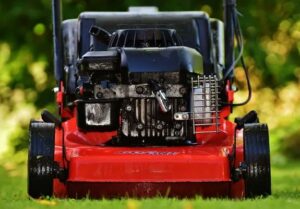
Chart For Common Reasons Why a Lawn Mower Starts Then Stalling or Stop
| Problem | Symptoms | Solutions |
| Dirty Air Filter | – Difficulty starting the engine | – Clean or replace the air filter according to the manufacturer’s recommendations |
| – Stalling after starting | ||
| Bad Spark Plug | – Difficulty starting the engine | – Check and replace the spark plug if necessary according to the manufacturer’s recommendations |
| – Stalling after starting | ||
| Stale Gasoline | – Difficulty starting the engine | – Replace the old gasoline with fresh fuel that meets the manufacturer’s specifications |
| – Stalling after starting | ||
| Clogged Carburetor | – Difficulty starting the engine | – Clean the carburetor according to the manufacturer’s recommendations |
| – Stalling after starting | ||
| Overfilling the Fuel Tank | – Difficulty starting the engine | – Drain the excess fuel and refill the tank with the recommended amount |
| – Stalling after starting | ||
| Loose or Broken Spark Plug | – Difficulty starting the engine | – Check the spark plug connection and replace the spark plug if necessary according to the manufacturer’s recommendations |
| – Stalling after starting | ||
| Faulty Carburetor Float | – Difficulty starting the engine | – Replace the faulty carburetor float valve according to the manufacturer’s recommendations |
| – Stalling after starting | ||
| Low Oil Level in Engine | – Difficulty starting the engine | – Check the oil level and add oil if necessary according to the manufacturer’s recommendations |
| – Engine running roughly or making unusual noise | ||
| Bad Battery Connection | – Difficulty starting the engine | – Clean and tighten the battery terminals and cable ends or replace the battery with a new one that meets the manufacturer’s specifications |
| – Stalling after starting | ||
| Faulty Starter Motor | – Difficulty starting the engine | – Have the starter motor checked by a professional mechanic or lawn mower repair technician |
| – Stalling after starting | ||
| Corrosion on Battery Terminals | – Difficulty starting the engine | – Clean the battery terminals and cable ends with a wire brush and baking soda mixture, apply petroleum jelly or dielectric grease afterward |
If your lawn starts doing backfiring you should know about its reasons and solutions which may be done before a professional to hire. If your lawn mower is backfiring, then read us here with details.
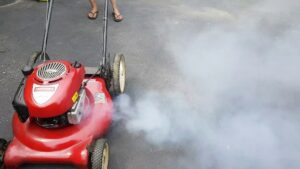
Reasons – Lawn Mower Starts Then Stops
Dirty Air Filter
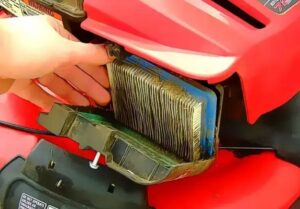
- Symptoms: A dirty air filter can cause the engine to have reduced performance, difficulty starting, and eventually stall. This happens because the air filter prevents dirt, debris, and other particles from entering the engine and causing damage.
- Solution: Regularly clean or replace the air filter to fix this problem, according to the manufacturer’s recommendations. To clean the air filter, remove it from the mower and gently tap it on a hard surface to remove any dirt or debris. If it’s heavily soiled, you may need to wash it with soap and water, let it dry completely, and then reinsert it into the mower. If it’s damaged or beyond repair, replace it with a new one.
Bad Spark Plug
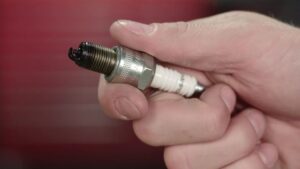
- Symptoms: A bad spark plug can cause the engine to have difficulty starting, rough idling, and eventually stall. This happens because the spark plug ignites the fuel and air mixture in the engine’s combustion chamber.
- Solution: To fix this problem, check the spark plug regularly, according to the manufacturer’s recommendations. Remove the spark plug from the mower and inspect it for any signs of wear, damage, or fouling. If worn or damaged, replace it with a new one that matches the manufacturer’s specifications. If it’s fouled, clean it with a wire brush or replace it with a new one.
Stale Gasoline
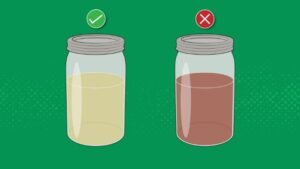
- Symptoms: Stale gasoline can cause the engine difficulty starting, rough idling, and eventually stall. Gasoline can become stale if it sits in the mower’s tank too long or contains too much ethanol.
- Solution: To fix this problem, drain the old gasoline from the mower and replace it with fresh fuel that meets the manufacturer’s recommendations. You can use a siphon or drain plug to remove the old gasoline from the tank. Be sure to dispose of the old gasoline properly. Once the tank is empty, add fresh fuel free of ethanol and meet the manufacturer’s recommended octane rating.
| When you decide about the gasoline for your mower, you must get confused about whether you can use synthetic gasoline. If so, we have the solution in our blog post for your convenience. |
Clogged Carburetor
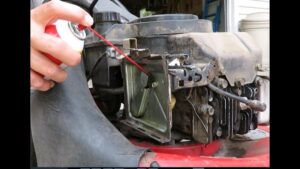
- Symptoms: A clogged carburetor can cause the engine difficulty starting, rough idling, stalling, and reduced performance. The carburetor is responsible for mixing the fuel and air that enters the engine’s combustion chamber.
- Solution: To fix this problem, thoroughly clean the carburetor, following the manufacturer’s recommendations. This involves removing the carburetor from the mower, disassembling it, and cleaning the components with carburetor cleaner. Remove debris, varnish, or other buildup from the carburetor’s jets, passages, and float bowl. If the carburetor is severely damaged or clogged, you may need to replace it with a new one that matches the manufacturer’s specifications.
Overfilling the Fuel Tank
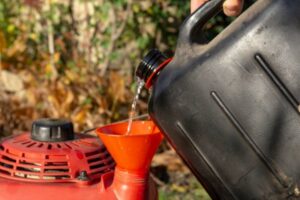
- Symptoms: Overfilling the fuel tank can cause the engine to flood, making it difficult to start and cause it to stall. Fuel may also leak out of the carburetor or fuel lines if the tank is overfilled.
- Solution: Drain excess fuel from the tank and fuel lines to fix this problem. This may involve removing the fuel tank or line and draining the fuel into a suitable container. Be sure to dispose of the excess fuel properly. Once the fuel level is recommended, try starting the mower again.
Loose or Broken Spark Plug Wire
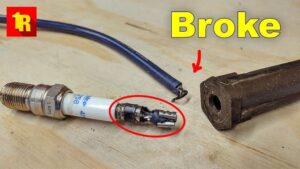
- Symptoms: A loose or broken spark plug wire can cause the engine to have difficulty starting, rough idling, and eventually stall. This happens because the spark plug wire transmits the electrical signal from the ignition coil to the spark plug.
- Solution: To fix this problem, regularly check the spark plug wire, according to the manufacturer’s recommendations. Reattach it to the spark plug and ignition coil if it’s loose. If it’s broken, replace it with a new one that matches the manufacturer’s specifications.
Faulty Carburetor Float Valve
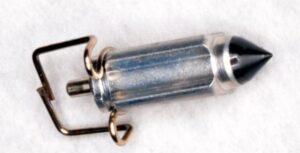
- Symptoms: A faulty carburetor float valve can cause the engine to flood, making it difficult to start and cause it to stall. This happens because the float valve is responsible for regulating the flow of fuel into the carburetor’s float bowl.
- Solution: To fix this problem, replace the faulty carburetor float valve with a new one that matches the manufacturer’s specifications. This may involve removing the carburetor from the mower, disassembling it, and replacing the faulty float valve.
Low Oil Level in Engine
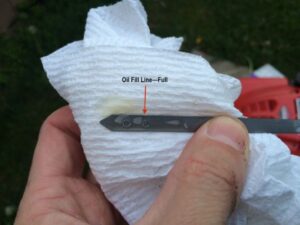
- Symptoms: A low oil level in the engine can cause the engine to seize up or stop running altogether. This happens because the oil lubricates the engine’s internal components, preventing them from wearing out or overheating.
- Solution: To fix this problem, check the oil level regularly, according to the manufacturer’s recommendations. If it’s low, add the engine’s recommended type and amount of oil. Check the oil level again after running the engine for a few minutes to ensure it’s correct.
Bad Battery Connection
- Symptoms: A bad battery connection can cause the engine to have difficulty starting and eventually stall. This happens because the battery provides the electrical power to the starter motor and ignition system.
- Solution: To fix this problem, check the battery connection regularly, according to the manufacturer’s recommendations. If it’s loose or corroded, clean the battery terminals and cable ends with a wire brush and tighten them securely. If the battery is damaged or not holding a charge, replace it with a new one that matches the manufacturer’s specifications.
Faulty Starter Motor
- Symptoms: A faulty starter motor can cause the engine to have difficulty starting and eventually stall. This happens because the starter motor turns the engine over when you turn the key or push the starter button.
- Solution: To fix this problem, you should have the starter motor checked by a professional mechanic or lawn mower repair technician. They can diagnose the problem and replace faulty components, such as starter solenoids or brushes.
Corrosion on Battery Terminals
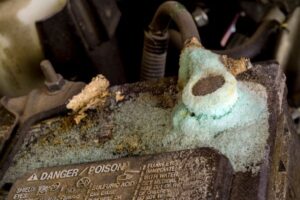
- Symptoms: Corrosion on the battery terminals can cause the engine to have difficulty starting and eventually stall. This happens because the corrosion can prevent the battery from providing a strong electrical current to the starter motor and ignition system.
- Solution: To fix this problem, clean the battery terminals and cable ends with a wire brush and a mixture of baking soda and water. Rinse the terminals with clean water and dry them with a clean cloth. Apply a thin coat of petroleum jelly or dielectric grease to the terminals and cable ends to prevent future corrosion.
Other Possible Causes of a Lawn Mower That Starts Then Stops
Here are some additional possible causes of a lawn mower that starts then stops:
Faulty Ignition Coil
- Symptoms: Difficulty starting the engine, engine running roughly or stalling
- Solution: Check the ignition coil for signs of damage or wear and replace it if necessary according to the manufacturer’s recommendations.
Loose or Damaged Electrical Connections
- Symptoms: Difficulty starting the engine, engine running roughly or stalling, electrical components not working
- Solution: Check all electrical connections for signs of damage or looseness and tighten or replace them as needed according to the manufacturer’s recommendations.
Low Oil Level
- Symptoms: Difficulty starting the engine, engine running roughly or stalling, unusual noise from the engine
- Solution: Check the oil level and add oil, if necessary, according to the manufacturer’s recommendations.
Engine Overheating
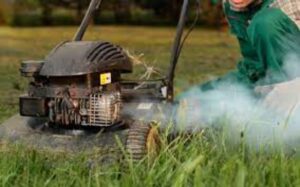
- Symptoms: Difficulty starting the engine, engine running roughly or stalling, smoke or unusual smells coming from the engine
- Solution: Check the engine’s cooling system for blockages or damage, and make any necessary repairs or replacements according to the manufacturer’s recommendations. Also, ensure the air intake and cooling fins are clear of debris.
How to Prevent Your Lawn Mower From Starting and Stopping?
Here are some ways to prevent lawn mower from starting and stopping:
Regular Maintenance and Inspection
- Change the oil and oil filter as recommended by the manufacturer
- Replace the air filter as recommended by the manufacturer
- Check and replace the spark plug as recommended by the manufacturer
- Inspect and tighten all nuts, bolts, and screws on the mower
- Check and adjust the mower’s blade as needed
- Keep the underside of the deck clean and free of debris
Proper Fuel Management
- Use fresh gasoline, and do not overfill the fuel tank
- Use a fuel stabilizer if the mower is not used for an extended time
- Drain the fuel tank and carburetor if the mower is not used for an extended time
Proper Storage During Off-Season
- Store the mower in a dry, covered area
- Remove the battery and store it separately in a dry area
- Cover the mower with a tarp to protect it from dust and debris
- Use a fuel stabilizer if the mower is not used for an extended period
- Follow the manufacturer’s recommendations for storing the mower
Conclusion
A lawn mower that starts and then stops can be caused by various issues, ranging from dirty air filters to faulty ignition coils. Preventive maintenance and proper fuel management can help avoid these issues, ensuring your mower runs smoothly. If your mower continues to experience issues, it is best to consult a repair professional. Properly caring for your lawn mower ensures that it lasts for years and provides a clean and well-maintained lawn.
